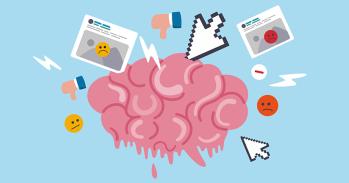
The proportion of children experiencing a probable mental disorder has increased over the past three years, from one in nine in 2017 to one in six in July this year, according to a report published by NHS Digital and co-authored by Professor Tamsin Ford at the University of Cambridge.
The proportion of children experiencing a probable mental disorder has increased over the past three years, from one in nine in 2017 to one in six in July this year, according to a report published by NHS Digital and co-authored by Professor Tamsin Ford at the University of Cambridge.
All who work with children and families need to be working hard to mitigate the impact of the pandemic, as mental health conditions in childhood predict worse adult health and reduce the ability to learn and achieve at school
Tamsin Ford
The rate has risen in boys aged five to 16 from 11.4% in 2017 to 16.7% in July 2020 and in girls from 10.3% to 15.2%3 over the same time period, according to The Mental Health of Children and Young People in England 2020 report.
The likelihood of a probable mental disorder increases with age, with a noticeable difference in gender for the older age group (17 to 22 year olds). 27.2% of young women and 13.3% of young men in this age group were identified as having a probable mental disorder in 2020.
This report looks at the mental health of children and young people in England in July 2020, and how this has changed since 2017. Experiences of family life, education and services, and worries and anxieties during the COVID-19 pandemic are also examined. The findings draw on a sample of 3,570 children and young people aged between 5 to 22 years old, surveyed in both 2017 and July 20204.
The report revealed that among girls aged 11 to 16, nearly two-thirds (63.8%) with a probable mental disorder had seen or heard an argument among adults in their household, compared to 46.8% of girls unlikely to have a mental disorder.
Professor Tamsin Ford from the Department of Psychiatry at the University of Cambridge said: “These findings suggest that more children are struggling with poor mental health than in 2017, particularly those reporting having a difficult time during lockdown – this deterioration in mental health was evident for boys and girls and in all ages from 5 years old to 22.
“The figures of older teenagers and emerging adults, particularly for young women are especially alarming, particularly as they replicate others findings from the UK Longitudinal Survey, which also had pre-pandemic data on the same people.
“All who work with children and families need to be working hard to mitigate the impact of the pandemic, as mental health conditions in childhood predict worse adult health and reduce the ability to learn and achieve at school.”
Sleep problems seemed to be a factor during the pandemic with more than a quarter (28.5%) of 5 to 22 year olds having problems sleeping. Again, those with a probable mental disorder reported experiencing sleep problems (58.9%) more than those unlikely to have a mental disorder (19.0%).
This was more common in girls, with 32.4% reporting sleep problems compared with 24.7% of boys. Issues with sleep affected 17 to 22 year olds (41.0%), more than any other age group.
One in ten (10.1%) children and young people aged 11 to 22 years said that they often or always felt lonely. This was more common in girls (13.8%) than boys (6.5%). Children and young people with a probable mental disorder were about eight times more likely to report feeling lonely often or always (29.4%) than those unlikely to have a mental disorder (3.7%).
When it came to receiving help for mental health problems during the pandemic, 7.4% of all 17 to 22 year olds reported they tried to seek help for mental health problems but didn’t receive the help they needed. This rose to 21.7% of those with a probable mental disorder.
The report also covers changes in household circumstances during the pandemic. It was revealed that children with a probable mental disorder were more likely to live in a household that had fallen behind with payments (16.3%) during lockdown, than those unlikely to have a mental health disorder (6.4%).
Overall 37.0% of 11 to 16 year olds and 36.4% of 17 to 22 year olds reported that lockdown had made their life a little worse, while 5.9% of 11 to 16 year olds and 6.7% of 17 to 22 year olds said it had made it much worse.
The report is published by NHS Digital, in collaboration with the Office for National Statistics, the National Centre for Social Research, the University of Cambridge and the University of Exeter.
Adapted from a press release by NHS Digital

The text in this work is licensed under a Creative Commons Attribution 4.0 International License. Images, including our videos, are Copyright ©University of Cambridge and licensors/contributors as identified. All rights reserved. We make our image and video content available in a number of ways – as here, on our main website under its Terms and conditions, and on a range of channels including social media that permit your use and sharing of our content under their respective Terms.




